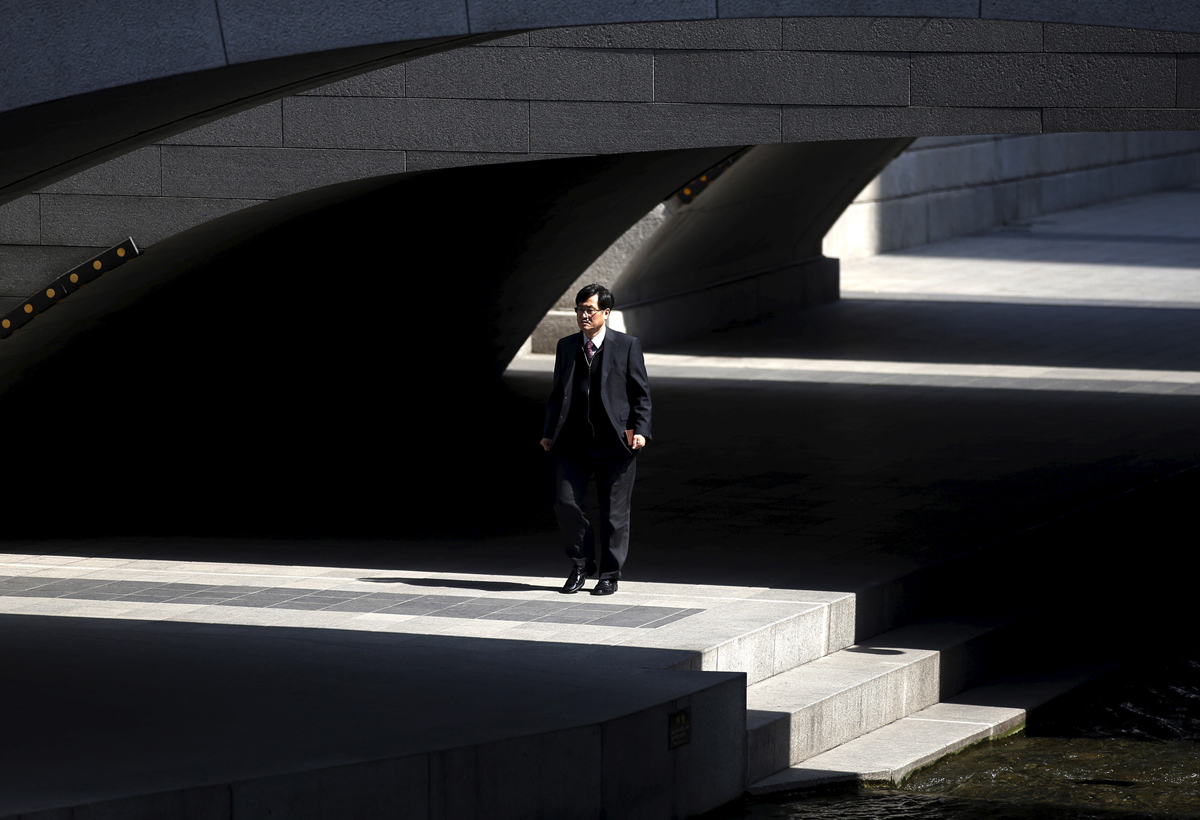The caption says, “A man walks along the Cheonggye stream in central Seoul, South Korea.” I think that’s an understatement.
How about: A man in a three-piece suit walks on, under, and along the concrete infrastructure of a public space? Or a a man in a three-piece suit walks on, under, and along the concrete infrastructure of a public space sharply sculpted by bright sunlight and dark shadows along a stream that is part of an urban water management system?
Or perhaps this: A man holding a small leather wallet hesitates on an elegant white and grey platform between the abyss behind and the abyss before him, while a stream flows by without remorse.
Or, a lone man walks tentatively through an empty space amid abstract structures, as if uncertain of what will happen next.
Or, the official walked through light and darkness to carry out his duties, small as they were; the river awaited him.
The spy considered whether he was too late, even though he was too early, too visible, and already a dead man.
As the well-dressed man walked on the clean city sidewalk by the beautiful bridge, he thought about jumping.
You get the idea. The stream is barely visible; the street and structure could be in any modern city, and the man is the anonymous embodiment of a type. The scene captures key elements of 20th century modernism: a lack of ornamentation cues the dominance of functionalist design, uniform materials, abstract spaces, geometrical forms, and black and white contrasts. In fact, not much of the world looks this barren or this purely engineered, and not many men wear suits anymore, and the image of the “man in the grey flannel suit” alone in the anomie of the concrete jungle is a figure from another era. And yet, here he is again, and perhaps more remarkable for that.
Let’s be clear what this image is not. It is not news. It is not emblematic of a significant event or current controversy. It is not a sign of the times or a new fashion or trending activity. And yet it is photojournalism, and it was selected for the Photos of the Week at the Atlantic.
More to the point, the who, what, where, and when really don’t matter much here. (If you look closely, he might be wearing a sweater rather than a vest. I’m not sure he’s carrying a wallet, either. Note that we’re not told the name of the street, etc.) Which leaves us with the why. And the why is doubly important, because what the photograph certainly is, is enigmatic. Although quintessentially modernist, it’s no longer clear whether the world depicted has a future. For all the strength and inertia of the concrete structures, they already seem almost permanently empty, and he seems both wittingly and unwittingly vulnerable. Kafka’s K comes to mind, which takes us even farther back. And by the way, where are the women? Now modernism becomes an empty space that we walk through but would not want to inhabit; and enlightenment serves primarily to demarcate the dark places, which are larger than we knew.
He is caught in the light, but like his shadow, he will soon disappear. Take a look at the last modern man.
Photograph by Kim Hong-Ji/Reuters.

Kinda like the art adorning most main fl entryways of giant corporate buildings. Large, abstract pieces completely divorced of any direct human emotion or interaction.